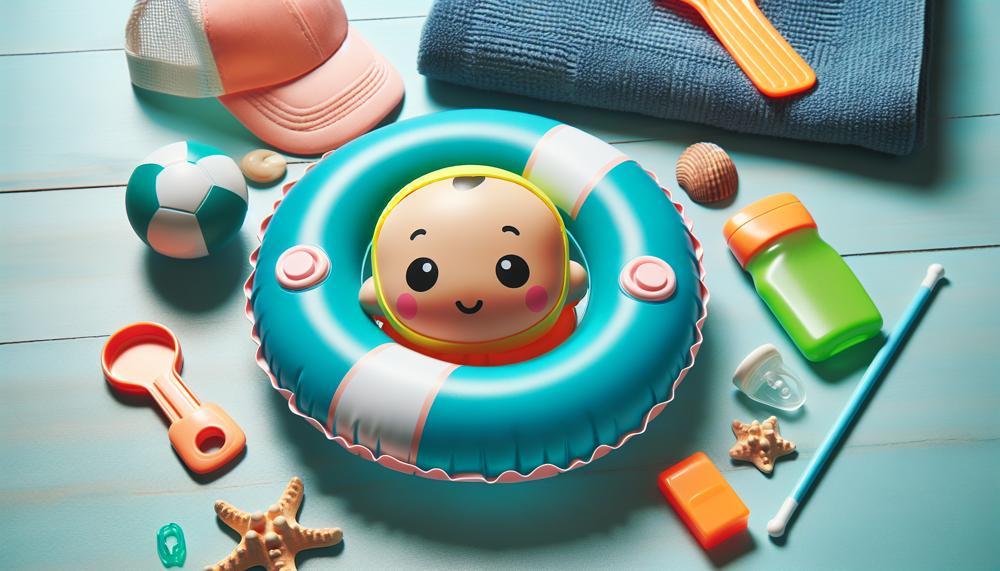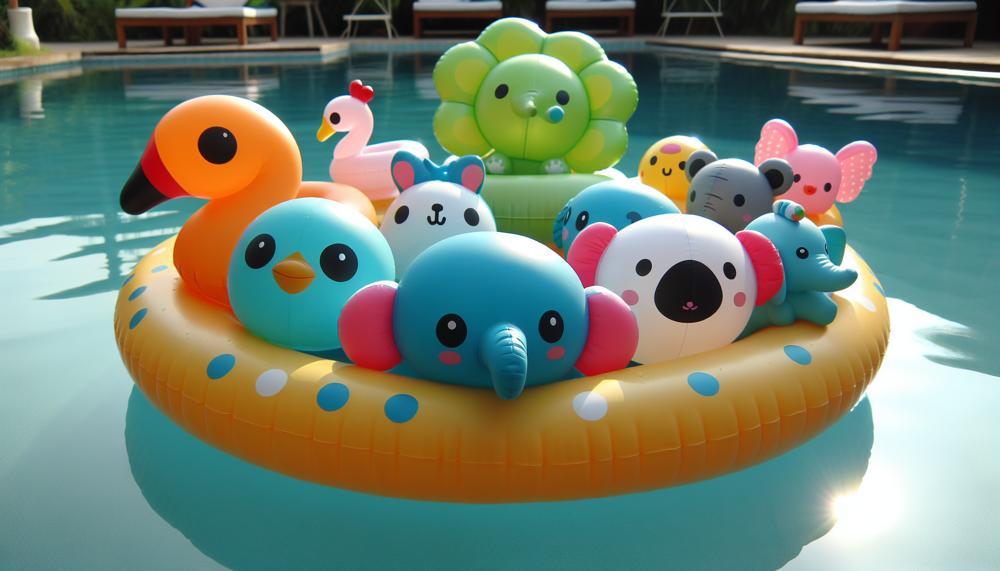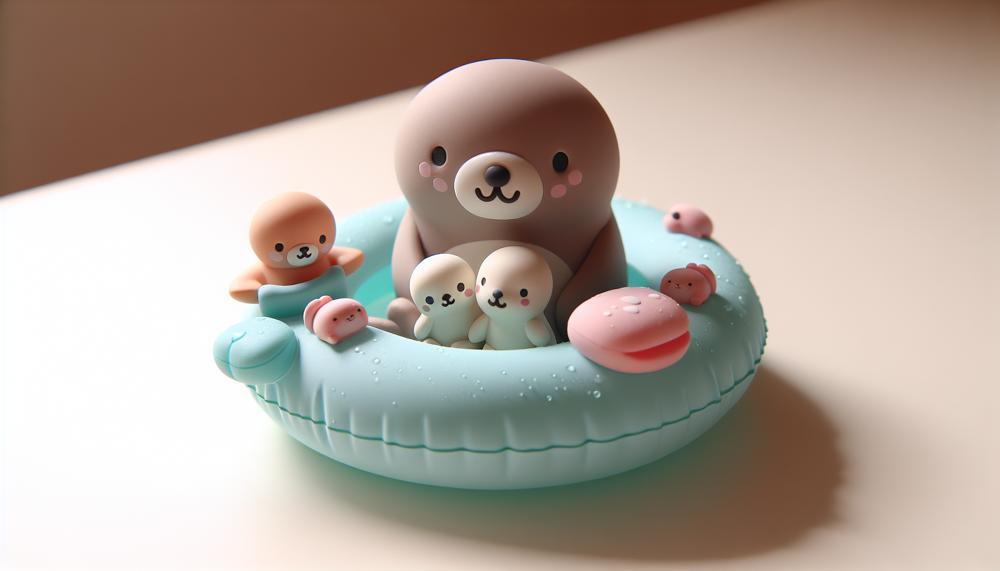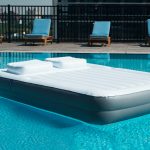In the summer, it’s time to take a dip in the pool with your little ones. But as a parent, your top priority is always the safety of your child. This is especially true when it comes to using baby pool floats.
So, before you jump into the water, here are some important things to keep in mind:
- Baby pool floats can be a fantastic way to introduce your little one to the water and provide them with a comfortable and enjoyable experience.
- However, it’s crucial to never leave your child unattended while they’re in a pool float. Accidents can happen even in shallow water.
- When choosing a pool float, look for one with a secure seat and safety straps that will keep your baby safely in place.
- Always check the weight limit of the float and make sure it can support your child’s weight.
- Inflatable pool floats may seem convenient, but they can easily deflate or tip over, putting your child at risk. It’s best to avoid them altogether.
- Additionally, make sure the float has a canopy or shade to protect your baby from the sun’s harmful rays.
As parents, we want our children to have fun and enjoy themselves while also being safe.
Are Baby Pool Floats Safe?
Contents
- 1 Are Baby Pool Floats Safe?
- 2 What makes baby pool floats different from regular pool floats?
- 3 Drowning risks and concerns associated with baby pool floats
- 4 The importance of proper supervision when using a baby pool float
- 5 Materials used in baby pool floats and potential risks
- 6 Tips for choosing a safe and secure baby pool float
- 7 Steps to minimize risks while using a baby pool float
- 7.1 Always supervise your baby while they are in a pool float.
- 7.2 Invest in a premium and properly fitting pool float.
- 7.3 Carefully follow the instructions and safety guidelines provided by the manufacturer.
- 7.4 Utilize additional safety measures, such as life jackets or swim diapers.
- 7.5 Avoid using inflatable pool floats in open bodies of water.
- 7.6 Keep the pool and pool float clean and well-maintained.
- 8 Conclusion
Baby pool floats can pose potential dangers that we should be aware of. These include drowning, sun exposure, and choking hazards. It is crucial that we take the necessary precautions to prevent these risks.
First and foremost, always closely supervise your child while they are in a pool float. Even if they can swim, accidents can happen in a split second. By staying vigilant, you can quickly react and prevent any potential danger.
Choosing the right float for your child’s age and weight is also important. A float that is too big or too small can be hazardous. It is recommended to follow the manufacturer’s guidelines and not to use a float meant for older children with a younger child.
Regularly inspecting the float for any tears or holes is another crucial step in ensuring your child’s safety. A damaged float can easily deflate and put your child at risk of drowning. Be sure to check for any weak spots before each use.
Additionally, be aware of any added features on the float that may pose a choking hazard. Some floats come with toys or attachments that could potentially break off and cause harm to your child. Always carefully read the warning labels and instructions before using a float.
Properly inflating the float and avoiding overloading it with too much weight is also essential for your child’s safety. An over-inflated float can easily tip over, while an overloaded one can sink, both putting your child at risk.
What makes baby pool floats different from regular pool floats?

| Key Factors | Baby Pool Floats | Regular Pool Floats |
| Safety and Stability | Wide base and low center of gravity prevent flipping for maximum safety | N/A |
| Non-inflatable seats | Comfortable and secure non-inflatable seats reduce the risk of punctures or deflation in the water | Inflatable seats may pose a risk of punctures or deflation |
| Built-in sun protection | Built-in sun canopies provide protection from harmful UV rays for babies’ delicate skin | N/A |
| Age-appropriate design | Specific designs for different age groups ensure safety and comfort for growing babies | N/A |
| Entertainment value | Built-in toys keep babies entertained while in the water, making swim time enjoyable for both parents and babies | N/A |
| Adjustable fit | Adjustable straps and flotation devices provide a secure and comfortable fit for growing babies | N/A |
| Fun designs | Inflatable animals or other fun designs make swim time enjoyable for both parents and babies | N/A |
When it comes to ensuring the safety and comfort of your little one, there are several key factors that make baby pool floats stand out from regular pool floats. These factors include stability and low center of gravity, non-inflatable seats, built-in sun protection, age-appropriate design, entertainment value, adjustable fit, and fun designs.
Safety and stability are top priorities when it comes to baby pool floats. These floats are designed with a wider base and lower center of gravity to prevent flipping and keep your baby safe in the water. This is especially important for young infants, who may not have the ability to balance themselves on a regular pool float.
Non-inflatable seats are another important feature of baby pool floats. These seats are not only comfortable for your little one, but they also reduce the risk of punctures or deflation while in the water. In contrast, regular pool floats often have inflatable seats, which may pose a risk of punctures or deflation.
Built-in sun protection is a key factor to consider when choosing a baby pool float. Both the Mambo Baby Float and LAYCOL Baby Swimming Float come with built-in sun canopies to protect your little one from harmful UV rays. This is especially important for babies with delicate skin.
Drowning risks and concerns associated with baby pool floats
These include design flaws or failure to meet safety standards, the possibility of the float tipping over or becoming unbalanced, the risk of deflation or puncture, and children developing a false sense of security while using a float. As a parent, it is your responsibility to thoroughly research and choose a well-designed float for your child’s safety.
Additionally, it is crucial to closely supervise your child while they are using the float and ensure that they do not become overly confident in their swimming abilities while using it.
One of the main concerns with baby pool floats is the possibility of design flaws or failure to meet safety standards. This can result in a float that is not stable enough to support the weight of a child or has inadequate safety features. To avoid this risk, it is essential to do thorough research before purchasing a float and choose one that meets all safety standards.
Another potential risk is the possibility of the float tipping over or becoming unbalanced. This can occur if the child leans too far in one direction or if there is an uneven weight distribution on the float. To prevent this, parents should always make sure that their child is properly seated on the float and monitor their movements closely.
The risk of deflation or puncture is also something to consider when using baby pool floats. If a float deflates or gets punctured while in use, it can cause the child to fall into the water unexpectedly. To minimize this risk, it is crucial to regularly check and maintain the float’s air pressure and ensure that there are no sharp objects nearby.
Finally, parents should be aware that using a float can give children a false sense of security about their swimming abilities. This can lead to them being more reckless in the water and potentially putting themselves in danger. It is essential to remind children that they still need to practice safe swimming habits, even when using a float.
The importance of proper supervision when using a baby pool float
Proper supervision is crucial when using a baby pool float to ensure the safety of your little one. This is because babies have limited control over their head and neck movements, making them more vulnerable to drowning while in a pool float.
And although pool floats may seem like a secure option for parents and caregivers, they can create a false sense of security, leading them to believe that their baby can be left unattended for a short period of time.
However, no safety device can replace the vigilant eye of an adult, as babies can easily tip over or slip out of the float, especially if there are waves or currents in the pool.
Additionally, due to their higher center of gravity compared to adults, babies are more prone to tipping over while in a pool float. This highlights the importance of closely monitoring your little one while they are in a pool float to prevent accidents and protect them from potential hazards such as choking or getting caught in the float.
In fact, my own personal experience with my baby taught me the importance of proper supervision when using a pool float. I remember thinking that my baby was safe and secure while floating in the pool, but suddenly she tipped over and nearly fell out of the float.
It was a scary moment that made me realize how quickly things can go wrong, even with seemingly safe equipment. From then on, I made sure to always keep my eyes on her and never leave her unattended while using a pool float.
Additionally, it’s important to note that every baby is different and may have their own unique limitations or behaviors while in a pool float. Some babies may be more active and move around frequently, making them more prone to slipping out of the float.
Others might have delicate skin that is susceptible to irritation from particular pool float materials. These are all factors that require close attention and supervision from parents and caregivers.
Materials used in baby pool floats and potential risks

Materials: Potential Risks
| Material | Potential Risks |
|---|---|
| Plastic |
|
| Vinyl |
|
| Nylon |
|
| PVC (polyvinyl chloride) |
|
When it comes to choosing materials for baby pool floats, safety should always be a top priority. Unfortunately, many common materials used in these products can pose potential risks to your little one’s health. Let’s take a closer look at some of these materials and the potential dangers they may present.
First up, we have plastic. While it is a durable and inexpensive choice, plastic often contains harmful chemicals such as phthalates. These chemicals can leach out over time, especially when exposed to heat or sunlight. This means that as your baby splashes around in the pool, they may be coming into contact with these toxic substances.
Next on the list is vinyl. Like plastic, vinyl can also contain phthalates and other toxic chemicals. But what makes vinyl particularly concerning is that it releases toxic fumes when heated. This means that on a hot summer day, the heat from the sun could be causing these harmful chemicals to enter the air your baby is breathing.
Another common material used in baby pool floats is nylon. While it may seem like a safe and durable choice, nylon can be treated with toxic chemicals such as fire retardants and waterproofing agents. These chemicals can also leach out into the water, putting your baby at risk for exposure while they enjoy their time in the pool.
Finally, we have PVC (polyvinyl chloride). This material has been linked to serious health issues such as cancer, reproductive problems, and respiratory issues. With such alarming risks, it’s important to avoid using PVC in any products that come into contact with your baby.
Tips for choosing a safe and secure baby pool float
When it comes to selecting a safe and secure baby pool float, there are numerous crucial elements that need to be taken into consideration. These consist of restrictions based on age and weight, the type of float being used, built-in safety features, the quality of materials, ease of use, and the importance of parental supervision.
For instance, age and weight limits play a significant role in determining the safety of a baby pool float. It’s important to note that these limits vary from product to product, so it’s essential to carefully read the manufacturer’s instructions before making a purchase. As a general rule, floats designed for younger babies will have lower weight limits compared to those designed for older children.
The type of float being used is another crucial factor to keep in mind. Different floats offer different levels of safety and security. For example, traditional inflatable arm floats may not provide enough stability for younger babies, whereas a sturdy pool ring with built-in seating may be a better option.
Safety features are also important to consider when choosing a baby pool float. Some floats come equipped with features such as safety straps or handles for added security. Others may have built-in sun canopies or mesh seats to prevent accidental falls into the water.
Material quality is another key aspect that should not be overlooked. Poorly made floats can easily puncture or deflate, putting your child at risk. It’s important to choose a float made with high-quality materials that can withstand the wear and tear of regular use.
Ease of use is also a crucial factor, especially for busy parents. Look for floats that are easy to inflate and deflate and can be stored compactly when not in use.
Lastly, parental supervision is vital to ensuring the safety of your child while using a baby pool float. Always keep an eye on your child, and never leave them unattended in the water.
Steps to minimize risks while using a baby pool float
Always supervise your baby while they are in a pool float.
No matter how secure a pool float may seem, it is never a substitute for proper adult supervision. Drowning can occur in a matter of seconds, so it is crucial for parents to continuously keep an eye on their baby while they are in a pool float. This means staying within arm’s reach at all times and never leaving your baby unattended, even for a short period of time period.
When it comes to your baby’s safety, it is vital to invest in a high-quality and properly fitting pool float. Cheaply made or poorly fitting floats can pose serious risks to your baby’s safety. Look for pool floats that are specifically designed for infants and have been thoroughly tested for safety. It is also important to ensure the float fits your baby snugly without any gaps or spaces where they could slip out.
Carefully follow the instructions and safety guidelines provided by the manufacturer.
Before using a pool float, carefully read and understand all safety instructions and warnings provided by the manufacturer. This will help you properly set up the float and avoid any potential hazards. Make sure to also adhere to any weight and age restrictions for the float.
Utilize additional safety measures, such as life jackets or swim diapers.
In addition to a pool float, it is recommended to use additional safety measures, such as a life jacket or swim diaper, for your baby. Life jackets provide an extra layer of protection while your baby is in the pool float, especially if they are not yet able to swim on their own. Swim diapers can also prevent any accidents in case your baby has a bowel movement while in the pool.
Avoid using inflatable pool floats in open bodies of water.
Inflatable pool floats are not designed for use in open waters such as lakes or oceans. The currents and waves can easily sweep them away, putting your baby at risk of drowning. Stick to using them in a controlled and enclosed pool environment.
Keep the pool and pool float clean and well-maintained.
Regularly cleaning and maintaining your pool and pool float is crucial for ensuring your baby’s safety. Make sure to regularly check for any tears, holes, or damage in the float, and clean it thoroughly after each use.
Conclusion
In conclusion, the safety of our precious children should always be our number one concern when it comes to using baby pool floats.
While these floats can provide a delightful and entertaining experience for our little ones, it is imperative to never leave them unattended. It is also crucial to select a float with appropriate safety features and weight limits and regularly inspect it for any damages that may compromise its safety.
Inflatable pool floats should be avoided due to their potential risks. Furthermore, parents must closely supervise their child while they are in a float and not rely on it as a substitute for proper adult supervision.
By taking these precautions, we can ensure that our children have a secure and enjoyable time.






